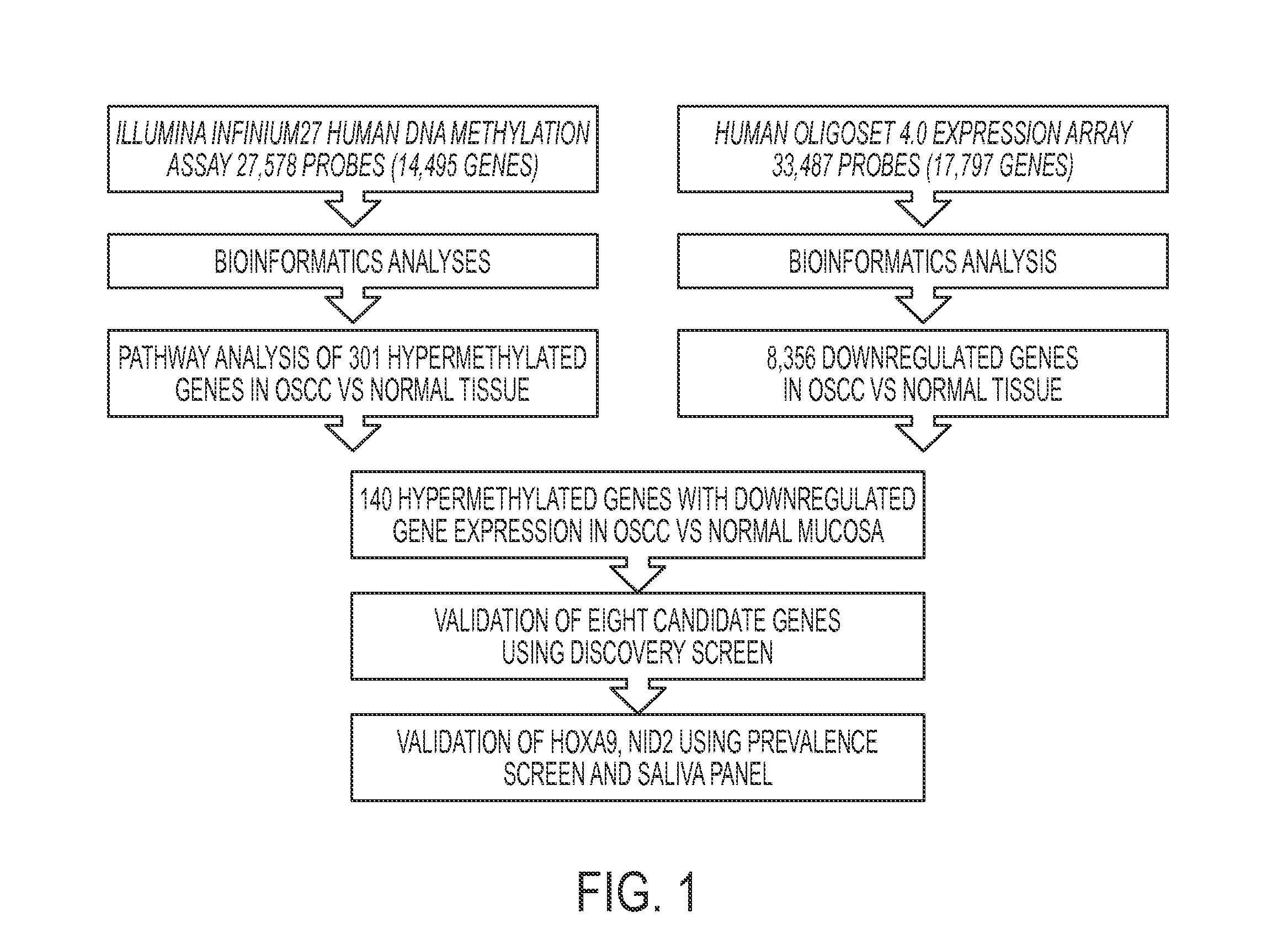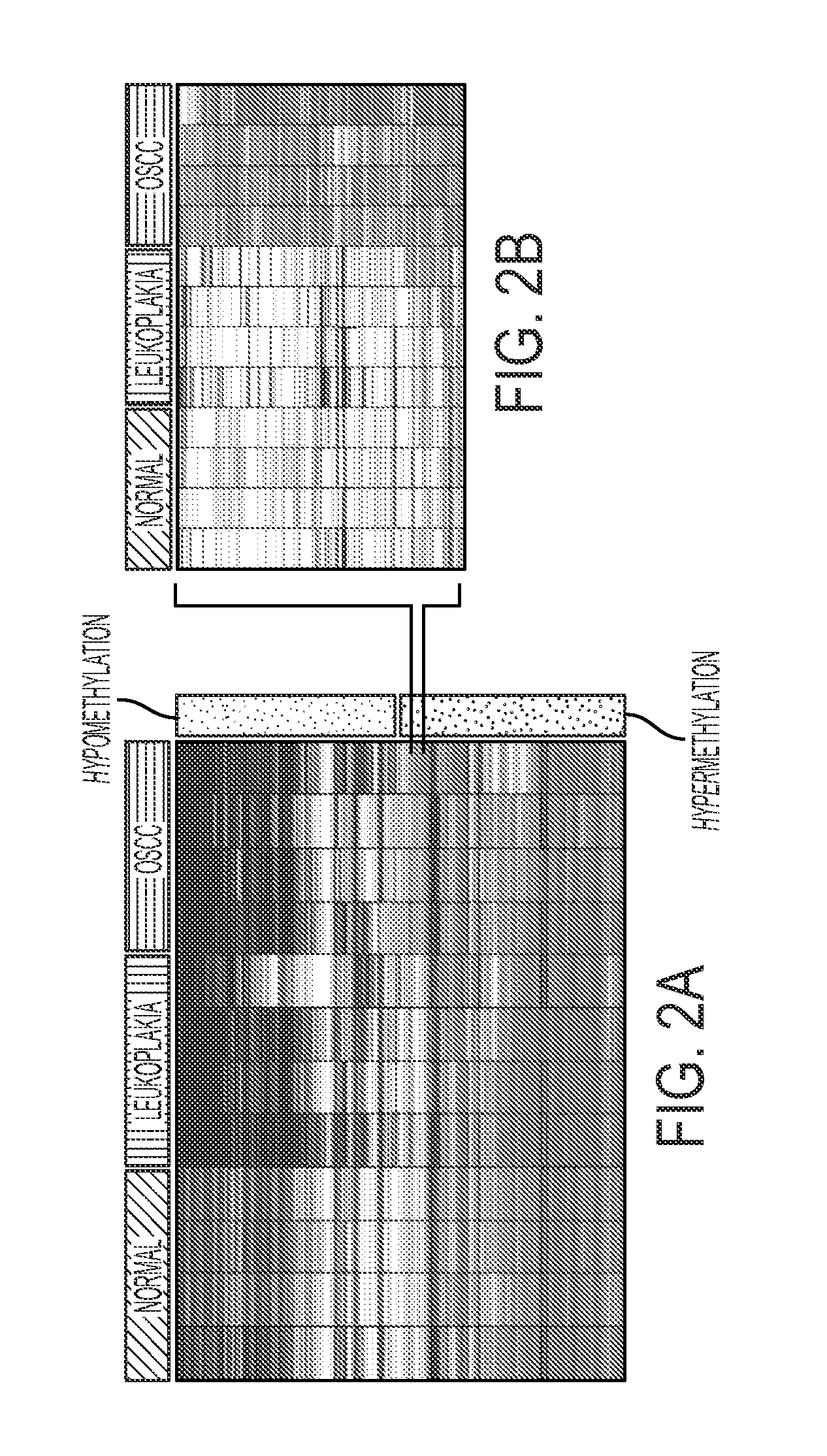Hypermethylation Biomarkers for Detection of Head and Neck Squamous Cell Cancer
- Summary
- Abstract
- Description
- Claims
- Application Information
AI Technical Summary
Benefits of technology
Problems solved by technology
Method used
Image
Examples
example 1
Methods
Patient Selection
[0062]Patients for this study were consented at hospitals in Baltimore, USA (n=143) and Madrid, Spain (n=36). Normal, premalignant and OSCC tumor tissue was collected from patients who visited the outpatient clinics of Hospital Gregorio Marañón in Madrid. OSCC tumor and adjacent tissue samples were collected at Hospital Ramon y Cajals in Madrid. Tumor and normal tissue and saliva rinses from HNSCC and healthy patients were collected at Johns Hopkins Hospital in Baltimore. Salivary rinses were obtained by rinse and gargle of 20 ml saline solution. All participants signed a consent form that clearly explained the risks and benefits of the study. The study was approved by the Ethics Committee of each participating hospital, as well as by the Johns Hopkins Institutional Review Board.
Samples
[0063]Tissue samples were frozen in liquid nitrogen and stored in −800 C. The salivary rinses were centrifuged, the supernatant was discarded and DNA was isolated from the pell...
example 2
Discovery Screen
Methylation Progression in OSCC
[0074]The bisulfite converted DNA from normal (n=4), leukoplakia (n=4) and Oral Squamous Cell Carcinoma (OSCC) tissue (n=4) samples was hybridized to the HumanMethylation27 DNA Analysis BeadChip assay, which quantitatively interrogates 27,578 CpG sites from 14,495 protein-coding gene promoters and 110 microRNA gene promoters at single-nucleotide resolution. The average beta values of all probes were log-transformed and used to generate a heatmap based on unsupervised hierarchical clustering. The clustering of all CpG loci (pa). Hypomethylated genes can be seen in blue and hypermethylated genes in red. A closer examination of differential methylation in a subset of genes shows a progression to hypermethylation in OSCC samples when compared to normal and leukoplakia samples. (FIG. 2b).
[0075]The bioinformatics strategy used to analyze the lumina data identified a progression of differential methylation events between the three tissue sampl...
example 3
Gene Ontology and Ingenuity Pathway Analysis of Hypermethylated Genes
[0077]The 301 hypermethylated differentially genes were analyzed for their biological significance using Geneontology (Spotfire®) and Ingenuity Pathway Analysis (IPA®). The differentially hypermethylated genes were found to be associated with pathways intimately related to oncogenic transformation: cell adhesion; cell proliferation; growth regulation; and cell death. (p<0.05)
[0078]The top associated network functions in IPA shown in are pathways directly related to tumorigenesis: cell signaling and interaction, nucleic acid metabolism, DNA replication, recombination and repair, cellular assembly organization, function and maintenance.
PUM
| Property | Measurement | Unit |
|---|---|---|
| Fraction | aaaaa | aaaaa |
| Fraction | aaaaa | aaaaa |
| Fraction | aaaaa | aaaaa |
Abstract
Description
Claims
Application Information
 Login to View More
Login to View More - R&D
- Intellectual Property
- Life Sciences
- Materials
- Tech Scout
- Unparalleled Data Quality
- Higher Quality Content
- 60% Fewer Hallucinations
Browse by: Latest US Patents, China's latest patents, Technical Efficacy Thesaurus, Application Domain, Technology Topic, Popular Technical Reports.
© 2025 PatSnap. All rights reserved.Legal|Privacy policy|Modern Slavery Act Transparency Statement|Sitemap|About US| Contact US: help@patsnap.com



